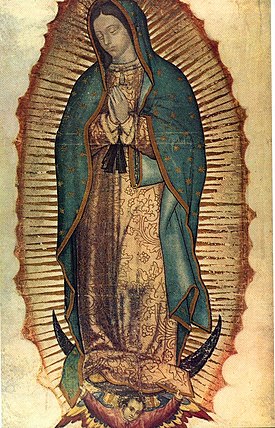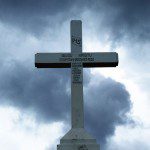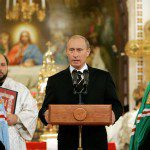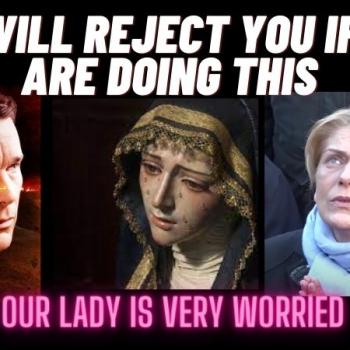 By Gene Sager for Mystic Post
By Gene Sager for Mystic Post
My spiritual journey began in an Anglo Protestant family in the Midwest, far from Tepeyac; Tepeyac — the Mexican village where Nuestra Senora de Guadalupe appeared to a Native American man (Juan Diego) in 1531. The ideas of a Marian apparition and devotion to Mary were totally foreign to me — something embraced by “others”.
I was drawn to Albuquerque and the University of New Mexico to study philosophy and religion. Only later would I understand that it was the Mexican-American culture of the Southwest that somehow drew me there and filled the gaps in my spiritual life. My Mexican-American friends introduced me to the Guadalupano tradition: the account of the apparition itself and the on-going devotions today. It was not the historical events five centuries ago, but the experience of the presence of Guadalupe in the here and now that moved me deeply. When I opened my mind and heart to Guadalupe I felt her awesome compassion and power.
It was 25 years ago that I converted to Catholicism and began devotions to Our Lady of Guadalupe. My wife is Mexican-American and I feel I have been adopted into her family and into their culture. I continue to grow in the faith, expanding my understanding and experience of Our Lady.
I used to think of Mexicans and Mexican-Americans as Guadalupe’s “chosen people”. But I now feel this term has an exclusive connotation: does it mean that other people are not Her chosen? Guadalupe’s words to Juan Diego were explicitly inclusive; she assures him that she is the merciful mother “of all mankind.” She is rightly called the “mother of all the living” (The Tidings, August 10, 2012).
Perhaps a series of concentric circles can help us picture the waves of Guadalupe’s compassion. A small circle around Tepeyac indicates the immediate site of her appearance. In time, people realized that her blessings encircled all of Mexico. Since the people of South and Central America are also Latino, Guadalupe’s compassion naturally extends to them as well. She is now called the Queen of the Americas (North and South America). And the expansive blessings of Guadalupe go out in equal potency to all peoples, to all the living.
The simple truth about Marian apparitions is that Mary takes a variety of different forms but remains the same in essence. Mary is not essentially Latina, Portuguese, French, or any other ethnic variety. I am fascinated by the multifarious apparitions of the Virgin Mary and by the other ways she is present to people all over the world. One of the most inspiring is the apparition of Our Lady of Akita who appeared to Sister Sasegawa, a deaf Japanese nun; the sister’s hearing was miraculously restored.
Some of the reported appearances of Mary are not designated as genuine apparitions by the Church. Sometimes this is because the evidence is questionable. Sometimes it is just not possible to obtain sufficient evidence. I know of numerous cases where the person blessed with the apparition has not made any official claims about the event. Mary appeared to a friend of mine, but he has told no one but me; he is embarrassed because the event occurred in his bathroom.
A “presence” or “appearance” need not involve a visible, human figure or a bright light. Often it is a sense of Our Lady’s consoling maternal assurance that we will survive the current frightening problem or crisis.
Another type of appearance is an icon (Greek:eikon). Icons function like a conduit or window, channeling the energy of holy beings to humans. I see no reason why we cannot treat mosaics, painting or statues of Mary as icons. Maybe I am a naughty Catholic, but I find Mary present in a mosaic on the wall of a coffee house near my home. Locals call her the Surfing Guadalupe. It is Our Lady of Guadalupe riding a wave on a surfboard, veil flowing in the wind. This striking 6’x6’ mosaic is on the outside wall of the Cafe Ipe in Encinitas, California, a half mile from Moonlight Beach. For the likes of me, it is a pilgrimage site.
Church officials cannot keep up with Our Lady’s devotees. Apparitions abound, and they are not the sort of thing readily proved or disproved. Catholic prelates may be asked to evaluate reports of iconic mosaics. Glowing paintings and healing miracles may stir some controversy. And in my neck of the woods, the ubiquitous image of Guadalupe may raise questions, especially when tattooed on an “inappropriate” part of the body.
Since officials can’t keep up, Marian devotion is a cage free spiritual movement. People ask if post-Vatican II Catholic policy is authoritarian or democratic. This is not quite the right question. It is, perhaps, “de facto democratic.” The movement is vast, officials and priests too scarce; the result is a free flowing movement.
I converted to Catholicism because I was a motherless child, spiritually speaking. My Protestant upbringing left a hole in my religious life. Devotion to Mary satisfies a spiritual need and I like its unregulated, grassroots feel. The Catholic mass is highly regulated and only a priest can perform it. But Marian devotions like the rosary or contemplation of an icon are totally unregulated.
Finally, I hasten to say again that Latinos are not Guadalupe’s chosen people. Nor is Guadalupe a “better” form of Mary than others. Never should we play the game of “My Mary is better than yours.” As for me, when I need my spiritual mother, it is always Guadalupe who appears to me. She listens and listens and cares. She gives me the courage to go on joyfully despite the difficulties of life. And she urges me to help protect God’s creation from overuse and abuse. She is indeed the mother of all the living.












